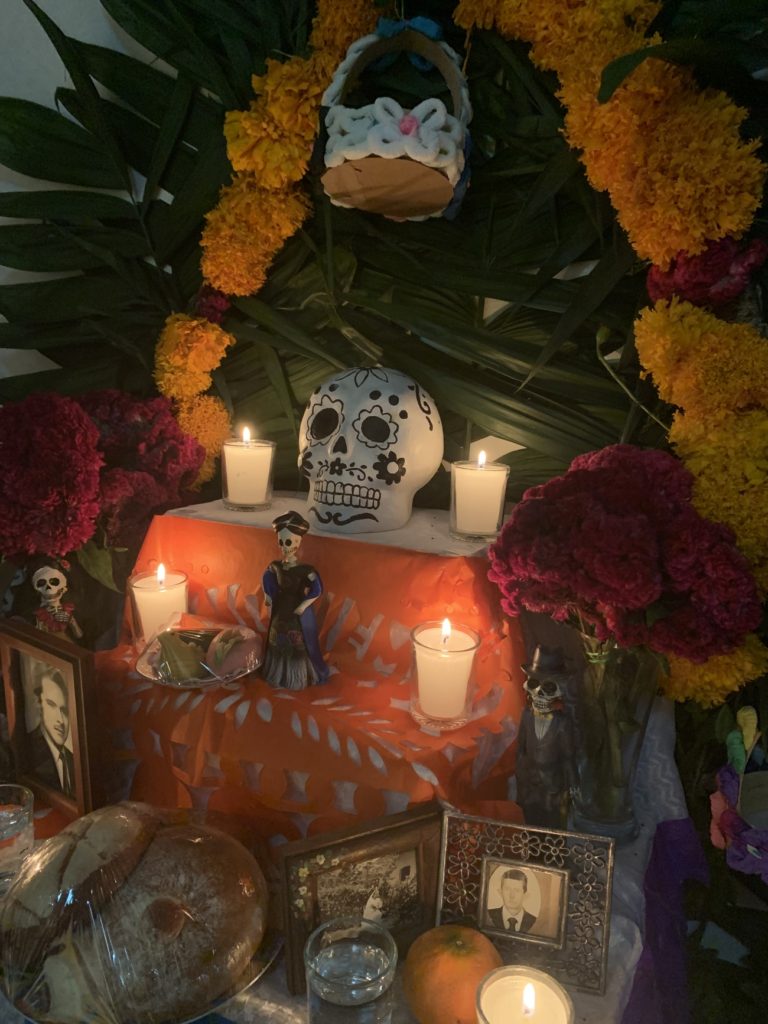For many, the month of October is associated with jack-o-lanterns, trick or treating, and haunted houses. The thrill of Halloween is looked forward to by many Americans, but often overshadows another festivity, Day of the Dead.
With a growing Mexican population in the US, the popularity of Day of the Dead has risen but it is still an often overlooked holiday. Day of the Dead is an unique and beautiful holiday that incorporates European and Meso-American cultures. Starting on October 31st through November 2nd, Day of the Dead is a time to honor those that have passed and celebrate their lives instead of mourn them. Families, friends, and neighbors unify to create beautiful memorials for their deceased loved ones and colorful parades pass through towns to honor the return of the spirits.
Those who celebrate Day of the Dead believe that by midnight, October 31st, the gates to Heaven open and for 24 hours the spirits of deceased children can visit their families. By midnight on November 1st, the gates of heaven are opened for everyone else. According to tradition, the journey from Heaven is exhausting so families set out their loved one’s favorite foods, drinks, games, sports, hobbies, and more.
A picture of the deceased family member is incorporated as well so their spirit can recognize their altar. Candles, marigolds, papel picado, and sugar skulls are added to make vibrant and distinct ofrendas. After spirits visit their family and their home, they replenish themselves with offerings from their ofrendas. Pets are celebrated during Day of the Dead as well. Toys and the favorite treats of pets that have passed away are added to ofrendas along with alebrijes, spirit animals that guide the dead on their journey back home.
Some of the most delicious treats during Day of the Dead are chocolate, hot cocoa, and pan de muerto, a special bread made only during this time. Mexican hot chocolate has a hint of cinnamon, and pairs perfectly with delicious, fluffy, sweet bread. Unfortunately, pan de muerto is a rare find in stores and does not compare to the breads made in Mexico. A warm cup of chocolate and pan de muerto are left on the ofrendas as another offering for the spirits. Spicy and sweet tamales, mole, fruits, and sweets are also added to the alters.
One of the most iconic parts of Day of the Dead is La Callavera Catrina, a skeleton ornamented with colorful makeup, jewelry, and clothing. Many replicate La Callavera Catrina during the Day of the Dead by painting their faces like a skull, but with lipstick and unique designs, like flowers and spider webs. People also wear colorful, old fashioned dresses, suits, sombreros, and flower crowns.
During parades, people show off their face paint and beautiful costumes. People dance to mariachi music and enjoy delicious foods. The most festive celebrations in Mexico are in the cities of Oaxaca. Comparsas, traditional Day of the Dead parades, are made up of marching bands and custom dancers. These comparsas weave their way through town and symbolize the return of the dead. A more family oriented tradition is visiting the gravesite of a loved one. Many return to their hometown to visit the graves of the dead and reconnect with family and friends. During Dead of the Dead, graveyards are adorned with orange marigolds and candles as people decorate and prepare the graves of the visiting spirits.
One of the most interesting parts of Day of the Dead is that people honor the deceased through celebrations. People celebrate the dead instead of spending the holiday mourning their losses. By discussing memories and stories of a loved one, communities can connect to honor someone that has passed on. Most cultures view death as an uncomfortable and scary topic, but Day of the Dead has shifted this paradigm. In Mexico, death is still frightening but during Day of the Dead people are able to confront dying through festivities. The vibrant reds, oranges, yellows, purples and pinks make death a more comfortable subject. Parades, family dinners, and decorating ofrendas teaches people that dying is natural, and instead of spending life fearing death people should enjoy life through celebrations and being involved in the community.
Currently, this sense of unity is lacking in the US as COVID-19 and politics have isolated individuals from their communities, friends, and even families. Unfortunately, In the past year, the US has experienced more deaths than ever due to COVID. If Day of the Dead was as popular in the US as it is in Mexico, Americans will have the chance to become connected with one another again and celebrate loved ones that have succumbed to COVID.





